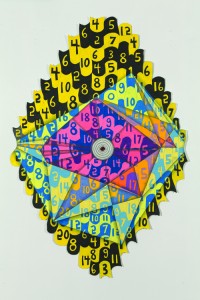A Zucchini Saves Art Exhibit
Quint Gallery’s summer art exhibit Horizon was a good idea when first conceptualized, but the end product offers newly discovered talent that sometimes seems chosen from narcissism. The exhibition consists of sixteen emerging artists. Each of these new talents were chosen by one of sixteen different renowned artists such as John Baldessari, Ann Hamilton, and Robert Irwin.
Of the sixteen emerging talents included in the exhibit, those who seem to be the most unexpected choices tend to have the strongest artworks in the Quint Gallery show. Unfortunately, many of the exhibit’s artists seem imitative of the artist who selected them. Thankfully, there are a few exceptions.

Jessica McCambly.
Detail of “Shatter 15 (series 2),” 2014 [unique].
Acrylic & silver-coated glass on paper; 10″ x 10″ (unframed).
© Jessica McCambly. Photo courtesy Quint Gallery.
McCambly’s works stand out all the more because she was chosen by an artist who works in a completely different medium as Philipp Scholz Rittermann is a photographer. Other established artists chose emerging artists that create work with similar working methodologies to their own. This aspect of similarity makes the established artists who made such choices seem egocentric and their choice of emerging artist seem derivative.

Rashell George
“Forever Falls: Fern Tree & Foliage,” 2012.
Collage; 17-1/4″ x 11-7/8″
© Rashell George. Photo courtesy Quint Gallery.
An example of this is the emerging artist Rashell George who was selected by the famous John Baldessari. George cuts and pastes together separate existing poster and magazine pictures, which Baldessari is renowned for doing. While George’s artwork is competent, the specter of Baldessari’s famous working method overshadows George’s similar work making it seem tired. This situation becomes a thick filter that a knowing viewer must strain to see through to find any originality in Ms. George’s imagery.
One particular work by Rashell George suffers the most. Titled “Forever Falls: Fern Tree and Foliage” (2012), the artist overlays and puzzles together different images to create a small scale view of a waterfall spilling a continuing stream through a jungle of ferns and flax plants. Repeatedly Baldessari’s shadow is cast over George from the two artist’s common use of combining appropriated images and continuous artery of line that travel through the different images.
An earlier work by George, “Framing Foliage: So Long to Thee” (2010) fares better as the procedure for making it is different. She takes a single poster and covers it with simple gray paint that covers everything in the image except some golden fall foliage at the top of the image. The presence of the orange foliage is enhanced poetically by the complementary dull, achromatic grey paint covering the rest of the shinier poster’s untouched foliage.
Many of the other emerging artists suffer a similar fate. Selected by Jean Lowe, Michael Sitaras’s small painted landscape, “Cardiff Beach” (2014), has a tonal hue structure that is virtually identical to Jean Lowe’s large scale painted installations. Also, Joseph Huppert’s small minimalistic, rectilinear shaped images made from electrical tape are similar to the minimalism of Robert Irwin, who selected Huppert. The slap-dash application of the tape is not as elegant as one would expect in high minimalism but the overall shadow of Robert Irwin’s minimalist rectangles cast a shadow over Huppert’s work to again dim the originality of another of the emerging artists.
Fortunately, three artists manage to break this fate. Lisa Young who was chosen by Nina Katchadourian, John O’Connor who was selected by Fred Tomaselli, and Heather Rasmussen who was selected by Catherine Opie.
Lisa Young’s 10-minute video “Drives” (2008) is peculiar fun. What seems to be an obviously stoned Ping-Pong ball that has sucked too much helium and nitrous oxide wobbles around the open sky. After continuously viewing the odd spectacle, one tries to comprehend what is happening. After rethinking the title, finally a revelation dawns that it is a product of a great editing job: a multitude of short scenes of airborne golf balls have been spliced together. The artist’s strategic brilliance of omitting the landscape in this cinematic montage is the divine secret that keeps the viewer in delightful wonderment. While selected by well-known artist Nina Katchadourian who also makes video, Lisa Young’s video work manages to stand on its own as “Drives” takes a viewer in a different conceptual direction than Katchadourian’s video work.

John O’Connor
“Twenty Seven,” 2012.
Colored pencil on shaped paper;
42″ x 28″ (unframed)
© John O’Connor. Photo courtesy Quint Gallery.
John O’Connor is a mathematical code maker of images. In his “Twenty Seven” (2012) a diamond shape of thick paper is covered with color pencil defining many curvilinear blocks containing numbers. Unless you actually remember your high school geometry, it is indecipherable as the numbers correspond to the characteristics of super-cube made from smaller cubes: 3-high x 3-wide x 3-deep (think of Ernő Rubik’s puzzle cube).
The numbers and colors of black and yellow, blue and pink, turquoise and yellow relate to potential alternate ways to paint the nine block faces on each side of a 3 x 3 x 3 cube. The beautiful complexity and forethought of the mathematical concept complements the intentionally awkward color pencil drawing. (Too bad the “Google” generation would probably have difficulty comprehending the very idea).
Another of O’Connor’s works is a nearly seven-foot tall color pencil ode to famous WWII British code breaker Alan Turing of Bletchley Park fame, who was key in deciphering messages encrypted by the Nazi’s notorious Enigma machine. After Turing’s significant contribution to the war effort and helping invent a prototype of the computer, in the 1950s he was tried and convicted for being a homosexual. His punishment was to be forcefully injected with estrogen for a year. The Red scare of communism caused this hero to be branded a security risk and conveniently tossed aside by the British. Not being allowed to continue his work, soon afterward Turing committed suicide.

Heather Rasmussen.
“Untitled (Zucchini and yellow chair on table),” 2013.
Pigment print; 20″ x 25″ (unframed). Edition 1 of 3, +1AP.
© Heather Rasmussen. Photo courtesy Quint Gallery.
Heather Rasmussen was chosen by documentarian photographer Catherine Opie. Rasmussen’s photos are clean and elegant but consciously betray themselves to become absurd unlike Opie’s work. Using extreme stark simplicity, her “Untitled (Zucchini and yellow chair on table)” (2013) is a spare image of a zucchini and vintage modern kitchen chair. At the left top corner of the overall image is an apparently seeming error that adds a needed air of casual candor, which is necessary for true comedy. In a manner akin to well thought out but casual artworks by the great Dada master Marcel Duchamp, the photograph becomes keenly low-brow funny. It is, indeed, an immensely scaled zucchini phallus propped erect through the open back crack of an upended chair, and the humor is all the more amplified by the serious clean white backdrop.
Of the sixteen emerging artists included in this exhibition, most are overshadowed by the more renowned artists that selected them. On paper the idea seems sound, but as realized, it didn’t work. Think of this exhibition as a failed empirical experiment as now it can be proved that the glaring spotlight of more famous artists tends to dim those artists who stand behind them in the relative chronology of art history.
Horizon was exhibited at Quint Gallery in La Jolla from 26 July through 6 September 2014.

Kraig Cavanaugh lectures about art history—specializing in Modern & Contemporary Art—as well as being an instructor of color theory, design, and studio art. He has curated numerous art exhibitions, authored exhibition catalogues, and written art reviews for several other print and online journals including “Artweek” (USA) and “Selvedge” (UK) magazines. Cavanaugh is also an invited member of the Association Internationale des Critiques d’Art (United States division), which is an NGO in official relations with UNESCO.

Good critique! became a good invitation to see the exhibit.